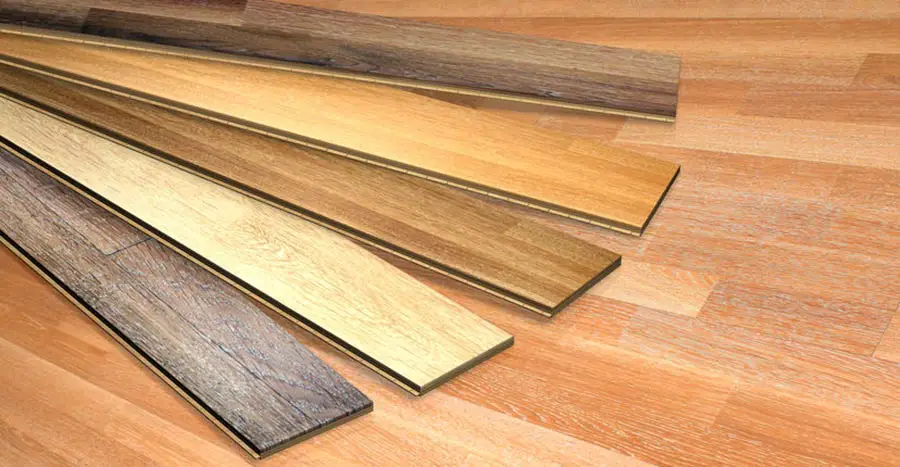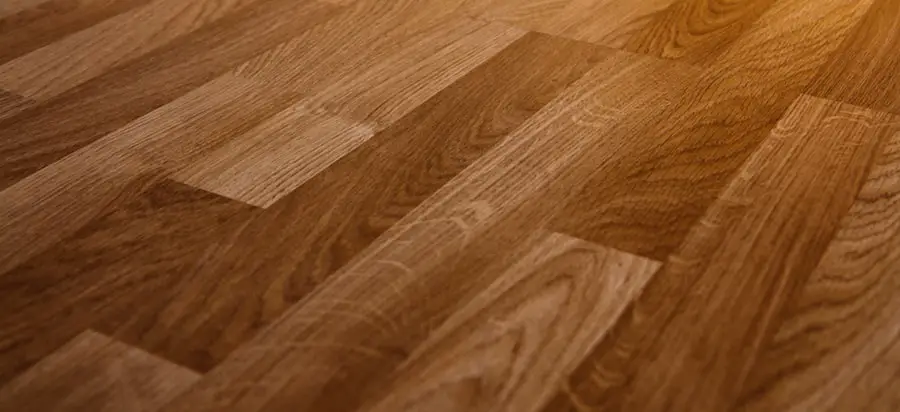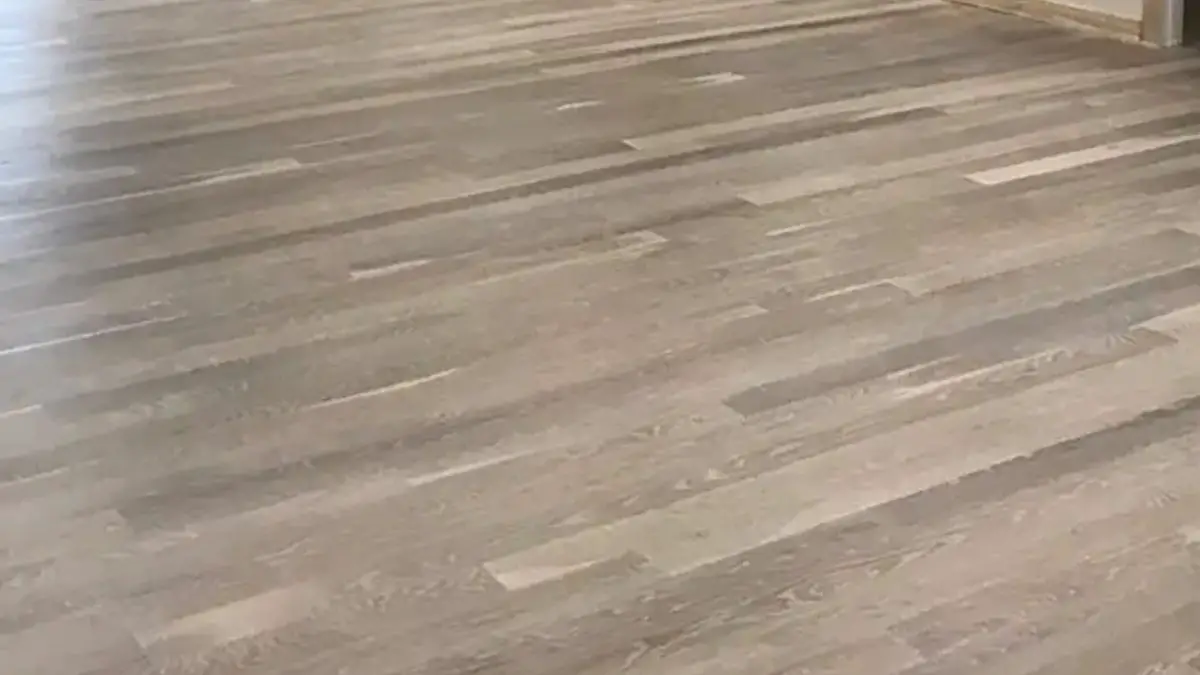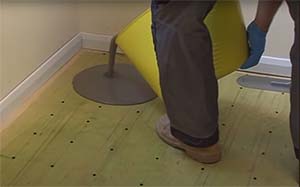
The right flooring can provide many years of beauty and enjoyment. When deciding which flooring to purchase can be a dilemma. One of these options is laminate flooring, which has gained popularity over several years. However, one primary consideration when choosing whether or not laminate flooring is the right flooring option for you and the laminate flooring last?
Laminate flooring can last somewhere between 15 to 25 years. The flooring’s lifespan is greatly dependent upon the quality of flooring and its maintenance throughout the years. Laminate flooring can last longer than 25 years as well if it is adequately taken care of. Laminate flooring in high-traffic areas can last closer to 10 years.
If you are contemplating getting laminate flooring in your house, there are many other aspects of this type of flooring that you should be aware of as well. In this article, we will be providing you with all the information you need regarding laminate flooring.
What is a Laminate Floor Made Of?
Laminate flooring is made up of multiple layers to ensure its durability while also ensuring that the floor has a neat and clean look. There are four main layers that the laminate flooring consists of, and these layers are namely the back layer, the core layer, the design layer, and the wear layer. These four layers are then fused using a process, which includes extreme pressure and high amounts of heat.
All of these four layers serve their own unique purpose, and thus, these layers need to be present in a laminate floor. As the name suggests, the back layer is the bottom layer of the flooring, and it is essential for ensuring that the floor plank remains protected against any moisture. This so-called back layer also provides balance and sturdiness to the floor as well.
The second layer is then fused onto this back layer, and this is the core layer. The core layer is a very high-density board that is exceptionally durable and sturdy. This core layer is significant because it protects the floor from moisture and also ensures that the laminate flooring does not get indented or damaged easily. The core layer will help the floor looking neat and shiny for a long time.
The design layer is then placed above the core layer, and this layer gives the laminate flooring its beautiful final finish. This layer is a photograph of the floor’s appearance that will show through onto the surface. The picture is exceptionally high-resolution, and this is where the diversity of different laminate flooring patterns comes into place.
The last or the top layer of the flooring is the wear layer, and this is essentially a clear, protective layer that ensures that the design layer remains secure. This layer is made up of aluminum oxide and is crystal clear to allow the design layer to show through. It also protects the flooring from stains, surface scratches, burns, and the design layer’s fading.
What Are Different Types of Laminate Floors Available?
If you are looking for diversity when it comes to the laminate flooring you choose to get, then you are in luck. The different types of laminate floors available are the different surface types as the diversity in laminate flooring comes from the look the surface has. Recently, many different looks and colors to choose from when it comes to laminate floors.
The most classic and straightforward finish is the smooth finish. This glossy, shiny finish looks very similar to how hardwood looks, and this is why it’s a classic choice for many homeowners. The good part about this type of laminate floor is that you can choose the amount of glossiness the flooring has, as there are high, medium, and low gloss finishes with this type of flooring.
If you want your flooring to look unique and have a more antique look, the distressed or hand scraped laminate flooring may interest you. The hand scraping process was previously only used for hardwood floors, but it is now also carried out on laminate flooring to give a unique look. This type of flooring is quite popular as of late due to its antique, old look.
The textured or embossed types of laminate flooring are yet another popular types available in the market. As the name suggests, this type of laminate flooring has a textured look, and upon first glance, it looks as if the print is embossed into the panel. However, it is only a print of the grain and is not exactly like regular embossing, but this print is a close match-up and has a lower maintenance level when compared to regular embossed floors.
Many different types of laminate flooring are available nowadays due to new, recent innovations in this area almost every year. So keep a lookout for any new flooring types, and you might find a unique look for your house and your style.
What Is The Top Layer of Laminate Flooring Made Of?
As we have discussed above, four layers make up laminate flooring. These layers are equally important, but perhaps one of the most important of these four layers is the top layer. The top layer, called the “Wear Layer,” gives the laminate flooring its elegant look while also protecting the layer underneath it.
The wear layer is often made up of many coats of melamine plastic along with aluminum oxide. The many coats ensure that their flooring has a hard-wearing film on top of it, protecting the layer from abrasions and indentations. Although the film is thin, it is incredibly durable and can protect the floor from moisture from minor spills due to its water-resistant qualities.

Is Laminate Flooring Waterproof?
The simple answer to this question is no; laminate flooring is not waterproof. However, the laminate flooring can be water-resistant due to its top layer being made up of melamine, which does not mean it is waterproof. To understand why laminate flooring is not waterproof, it is essential to understand the difference between waterproof flooring and water-resistant flooring.
Waterproof flooring means that the floor’s material is permanent and will not allow any water to penetrate the flooring. If water were to remain on the waterproof flooring surface, it would not be able to penetrate the flooring layers and cause damage. Whereas water-resistant flooring means that although the flooring can stop the water from damaging the floor layers if the water remains on the surface for an extended time, it will eventually penetrate the flooring and cause damage.
So, the top wear layer of laminate flooring ensures that the flooring has water-resistant qualities and can protect from moisture damage to an extent. However, the laminate flooring is not waterproof and can be severely damaged if water remains on its surface for a long time. So if you have spilled water, wine, or other fluids on your laminate floor, no matter how little, we strongly recommend cleaning it up right away before it damages the laminate floor.
Since laminate flooring started gaining some popularity, it has become a cult favorite for many homeowners. There is no doubt that laminated flooring has been improved upon and innovated majorly since it first came around. Thus, due to its innovation, it has many pros that make it superior to other flooring options. However, as with everything, there are some downsides to laminate flooring as well.
The Pros of Laminate Flooring
1. Laminate Flooring is Very Affordable
Laminate flooring is relatively inexpensive compared to other flooring options. Laminate flooring costs around $1 to $3 per square foot, which is relatively inexpensive for good quality and classy-looking flooring material. Even luxury vinyl plank flooring does not exceed the $10 mark, further explaining its affordability.
2. Laminate Flooring is Easy Installation
Laminate flooring is extremely easy to install. You will not need to hire a professional for its installation because you can easily do it yourself without much trouble at all. Ease of installation further reduces the cost. Even if you prefer to hire a professional to get laminate flooring installed, it is very inexpensive due to the relatively easy and fast task. The average price of getting laminated flooring installed will be about $5 per square foot, including the cost of labor and the flooring itself. Compared to the installation costs of other types of flooring, this is relatively cheap and affordable.
3. Laminate Flooring is Durable
As mentioned before, the composition of four layers that make up laminate flooring ensures that it is incredibly durable and sturdy. Mainly because the top layer comprises several melamine plastics and aluminum oxide coats, it is extremely tough and makes sure that you will not damage the flooring that easily. The top layer also provides an excellent stain resistance quality, making sure that your flooring will not get stained easily in case of spills.
4. Laminate Flooring is Easy to Maintain
One of the selling points of laminate flooring is that it is extremely easy to clean and maintain. A simple and quick mopping can make the flooring free of any dust, and the sweeping will also make sure there is no abrasive grit and grime on the surface. If you hate cleaning and looking for very low-maintenance flooring, laminate flooring can be a great candidate.
Alongside other pros, there are some downsides to laminate flooring as well.
The Cons of Laminate Flooring
1. Laminate Flooring is Susceptible to Water Damage
One of the main cons of laminate flooring is the possibility of water and moisture damage. Although laminate flooring is water-resistant, it is not waterproof and can easily be damaged by water or any moisture over a long time. Moisture damage potential is why it is not recommended to install laminate flooring in laundry rooms or bathrooms. Water damage will likely lead to a replacement of the flooring being required, and if that is a possibility you want to avoid, you might want to look for waterproof flooring options instead.
2. Laminate Flooring Can Be Noisy Underfoot
Since laminate flooring is synthetic and the top layer is quite hard, it can be quite loud when it is walked upon. The underfoot noises can be quite exaggerated, and this is one of the main reasons homeowners are hesitant to install laminate flooring in bedrooms.
3. Laminate Flooring Only Lasts About 15 Years
As we all know, refinishing any flooring type is a significant component in having a clean and neat-looking floor. However, laminate flooring cannot be refinished in such a way as hardwood floors can. Thus, once your laminate flooring has worn out and is damaged, you will probably need to be replaced. Replacement is not as big of an issue because the laminate flooring becomes cheap and inexpensive. However, it is still an issue for many people as it takes time to get the flooring replaced and can be a process, especially when floors need to be replaced in large rooms.
How You Can Use Laminate Flooring
You can install laminate flooring almost everywhere in your home. According to most manufacturers, laminate flooring is an ‘install anywhere’ kind of product. Be it your living rooms, basements, stairs, laminate flooring installations are highly recommended.
Nowadays, there is a popular trend in laminate flooring, which does not limit laminate flooring to just your floors, meaning that You can also use laminate flooring on your walls! With its easy installation, durability, and affordability, your walls can be laminated as well, making lamination an excellent decor agent. From your bedroom to your shelves, kitchen backsplashes, mounting, and bathroom vanities, lamination is a perfect option to upgrade the look.
How Long Does a Laminate Floor Last?
As mentioned prior, the average lifespan of laminate flooring is somewhere between 15 to 25 years. However, many people claim that laminate flooring can last up to 30 years with proper care and maintenance.
The main factor to keep in mind when it comes to predicting the laminate flooring’s lifespan is the quality of the flooring itself. Due to its popularity, there are many different varieties of laminate flooring available in the market, and in this variety, there are also other qualities available. The incredibly cheap and inexpensive laminate flooring may feel like a steal at the time, but it will cause a lot of trouble in a long time.
Low-quality laminate flooring is more prone to be damaged by moisture and water and easily scratched and indented. Thus, it is always recommended to invest in good quality laminate flooring so that you will not have to deal with the problems of refinishing or replacing the flooring every five years or so.

What Influences the Lifespan of Laminate Flooring?
Many factors can influence how long your laminate flooring will last—one of these factors of the flooring quality we have already discussed above. However, there are many other factors as well.
One of the critical factors that influence laminate flooring’s lifespan is the foot traffic the floor receives. To put it simply, if the flooring is in an area where many people and pets are walking over it, this will significantly impact the flooring’s lifespan. The more people walking over it, the more damage the flooring absorbs and the lower its longevity will be. Laminate flooring may last longer in a bedroom than in a living room because of reduced foot traffic.
Another major factor is the installation of the laminate flooring. Although this flooring type is relatively easy to install, it is crucial to do it correctly. If the flooring is not installed properly and is not fitted correctly, it will be more likely to become uneven or warp over time once it is being used.
It is often said that the laminate flooring’s thickness dramatically determines how long the floor will last. The thicker the flooring, the longer its lifespan will be. A thicker laminate flooring means that each layer of the flooring is adequate to bear damage and is likely to absorb the damage it receives with use.
When do You Need to Replace a Laminate Floor?
Now that we have discussed how long laminate flooring can last on average, you might wonder how exactly you will know when it is time to have your laminate flooring replaced. When it comes to flooring, replacement is an extremely normal part of the process because any floor endures a lot of wear and tear in the forms of spills, shoes, furniture, and pet claws if you own any pets. So it is only a matter of time that the flooring will start to show signs that it needs to be replaced with a fresh set.
When it comes to laminate floors, the main sign that you need to replace the flooring is when the panels’ edges start to peel up and away from the floor. Peeling shows that the adhesive is starting to come loose. Warping of the laminate flooring will also be a key indicator in letting you know that it is time to replace the flooring.
What Should You Not Put on Laminate Floors?
When it comes to laminate flooring protection, an important factor to consider is what to and what not to put on it. A major component of what goes onto the laminate floors is the stuff you use to clean the floor with. It is highly advised not to use abrasive cleaners, steel wool, and strong chlorinated or ammoniated cleaners when it comes to cleaners. This is because such abrasive and intense cleaners can eat away the laminate flooring’s top layer and cause potential damage.
Alongside this, using soap and water or any other liquid cleaners is also not advised as it is important to remember that laminate floors are prone to get damaged by moisture. Thus, by washing the floor with soap and water, you are risking the laminate flooring to swelling, delamination, and even warping.
Although laminate flooring may look like wood, it is important to remember that it is a synthetic material, and so, we recommend not to use wood cleaners on this type of floor. Moreover, it is also recommended not to use any polishing or buffing machine on your laminated floors to damage the flooring finish and cause unnecessary scratches.
How do I Protect My Laminate Floors From Heavy Furniture?
Protecting your laminate flooring from heavy furniture is extremely important because heavy furniture is one of the primary sources of damage to the flooring. Whether it is dragging the furniture on the flooring or simply just having the furniture sit in one place over many years, there are simple tricks you can utilize to protect your flooring.
When moving furniture into a room with new laminate flooring, the best way to make sure that you don’t end up dragging the flooring’s heavy furniture is by placing furniture sliders or moving discs under the feet of the furniture. These tiny plastic discs have padding on one side and allow the furniture to glide across the flooring easily without causing any damage to the laminate flooring. It is also recommended that once you have placed the furniture where it needs to be, add a layer of padding underneath the feet on the furniture to make sure that it does not crack or dent the laminate flooring over time.
What Can You Put on Laminate Floors to Protect Them?
There are different ways to protect your laminate flooring and make sure they last quite a long time. As mentioned above, to prevent furniture from cracking or denting your laminate flooring, add a layer of padding under the furniture, which will absorb some of the furniture’s weight while also ensuring that the edges of the furniture do no scratch the laminate flooring. Many people use felt as padding because it is affordable and easy to find. However, there are many different padding available in the market targeted towards protecting laminate flooring from furniture.
One of the easiest ways you can protect your laminate flooring is by adding a rug to it! Rugs not only protect your flooring but will also give your room a new, cozy look and will keep your feet warm.
One of the most common mistakes people make when attempting to protect their laminate flooring is adding a sealant on top of the flooring. Additional sealants are not recommended because the laminate flooring’s top layer comprises melamine plastic and aluminum oxide, which pretty much acts like a sealant itself. Hence, this layer should not be tampered with, and adding any sealants, finishes, or even stains is not recommended because it will only cause the laminate flooring to lose its longevity and shine.
What is the Best Way to Clean Laminate Floors?
Laminate floors are probably the easiest to clean because all they require is a mop or a broom with very soft bristles. Mopping or sweeping will get rid of all of the dirt on the surface of the laminate flooring and clean it without causing any damage to the flooring.
If you want to add shine and clean your laminate flooring thoroughly, you can invest in a good quality laminate floor cleaner. There are many different kinds available on the market, and some of them are affordable yet do their job pretty well. If you do not wish to spend money on a cleaner, you can use a vinegar and water solution. Although many professionals discourage using this solution on laminate flooring, it can work in a pinch if you are out of a cleaner.
The most crucial step when it comes to cleaning laminate floors is drying the flooring. Once you’ve mopped away the cleaner, make sure to dry the laminate to ensure that there is absolutely no liquid on the surface of the flooring that can lead to moisture damage.
What to do With Old Laminate Flooring
When it comes time to replace your old laminate flooring your options are somewhat limited. You can either repurpose it or recycle it.
Repurposing old laminate flooring takes some creativity. We created a list to help you know what to do with leftover or old laminate flooring.
Most people (and contractors) trash old laminate flooring. However, while laminate may not be pretty to look at after it has worn out, it doesn’t degrade like wood does and can last hundreds of years in landfills. Try to find a landfill that allows you to recycle laminate flooring.
Recycling laminate consists of chipping the material and reusing it for other purposes, like making new laminate flooring.
How Long Laminate Floor Last? Now You Know
Laminate floors can be a good option for someone who wants a sleek, clean finish with a beautiful design on their flooring. Most people who choose laminate flooring go for a hardwood type finish because laminate flooring looks just as good as hardwood flooring without most of the maintenance that comes along with wood. This flooring type is affordable, easy to install, and can last quite a long time if appropriately taken care of and maintained. Thus, this is why it continues to be a classic option when it comes to flooring.







